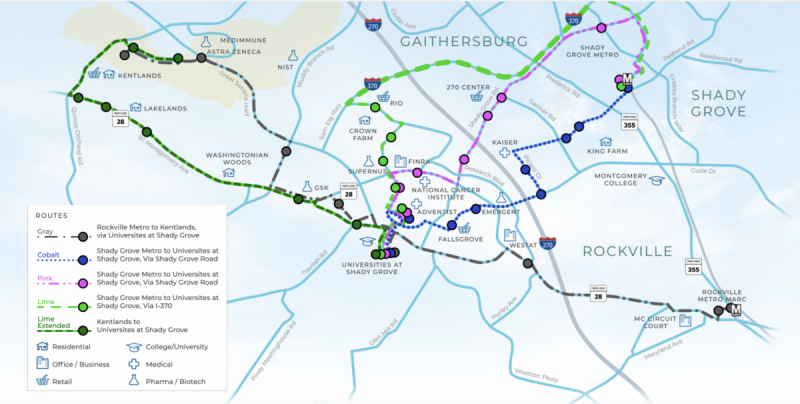How a new transit network will improve transportation in western Montgomery County

The Great Seneca Transit Network will service the Shady Grove Metro and the science corridor to the west by Famartin licensed under Creative Commons.
A new transit network is coming to western Montgomery County that’s not quite bus rapid transit (BRT), but more rapid than the existing Ride On Bus. This is the Great Seneca Transit Network (GSTN), which will serve the fast-growing Great Seneca Science Corridor, including the Shady Grove Metro, the Universities at Shady Grove, Adventist Hospital, and other key destinations.
This relatively quick, inexpensive project might just be a blueprint for the kind of transit improvement that will make for a more sustainable, equitable region.
The GSTN will serve “an area of the county where there is a lot of new development happening, in particular biotech, healthcare and education,” said Joana Conklin, the Bus Rapid Transit Program manager for Montgomery County.
“This will connect a lot of really major job centers,” added Jane Lyons, Maryland Advocacy Manager at the Coalition for Smarter Growth. “A lot of the job growth that we’ve seen is in the Great Seneca Science Corridor” is car-dependent, “so bringing better transit will help guide that growth in a direction that is more transit oriented.”
Conklin also emphasized healthcare equity: “there’s a major Adventist hospital located in this area” that the new transit will serve.
The first two segments of the network are the Pink line, which will run from Shady Grove Metrorail Station to the Life Sciences Center near Shady Grove Hospital, and the Lime line that will operate from Shady Grove Metro to Crown Farm and the heart of the Life Sciences Center. They are scheduled to open in early 2025.
The county has already provided the full $26 million in funding, and over $30 million more will be needed to complete the network, which will include three additional lines serving Rockville Metro, the Kentlands, and other destinations.
The new bus network would serve the area featured in the map by MCDOT.
The history of how the GSTN came to be is long and twisty. The network is a temporary replacement for the earlier envisioned Corridor Cities Transitway, a fully realized BRT system run by the State of Maryland that was abandoned by the Hogan administration in 2019. “Up county has been neglected transit-wise for a really long time despite Gaithersburg and Germantown having some of the biggest populations that don’t have a vehicle,” said Lyons.
The GSTN gets only part of the way there, ending at southern Gaithersburg. “It was never intended to be a replacement for the CCT, and it’s basically a fraction of the cost,” said Conklin. “But it was something that could be implemented quickly that would meet the need now, as we’re waiting for larger BRT project to hopefully someday be funded.”
Although it shares many features with Montgomery County’s planned Flash BRT network, the GSTN is technically part of another system, Ride On extRa, which currently consists of the 101 express bus on Route 355. The GSTN, unlike the 101, will have dedicated lanes along parts of its routes, service every 10 to 15 minutes, according to Conklin, and transit signal priority that will provide it an early green light, at times. Other features include zero emission buses, queue jumps that enable turning, and pedestrian improvements that ease station access.
What makes the GSTN different than full BRT?
That’s a murky question, as BRT is a series of items, not a binary on or off concept. Having dedicated lanes on only part of the route and along the outer lanes rather than the medians, makes it less BRT, although Flash has only intermittent dedicated lanes. But the GSTN will not have the long, articulated buses and “grand and elaborate” stations of Flash, said Conklin. In addition, she explained, it won’t have the fully dedicated lanes, including an aerial section over the Kentlands envisioned for the CCT, instead repurposing existing traffic lanes where possible.
Perhaps the crucial difference from the CCT is the lack of service to northern parts of the county, including much of Gaithersburg, Germantown and Clarksburg. “The full CCT would really connect up county a lot better with the mid county area,” said Lyons.
If the CCT is unlikely to reappear in its original version, the hope is to reformulate it as the Corridor Connectors, planned to coordinate with the Flash network and a reimagined Ride On. The question is whether the county can get all these moving parts together, fund them, and weld them into a cohesive transit network.
If so, Montgomery County will have taken a giant leap toward meeting its ambitious equity and climate goals for the twenty-first century.
